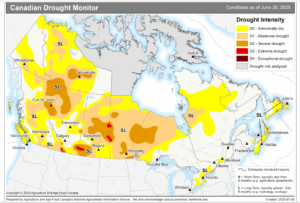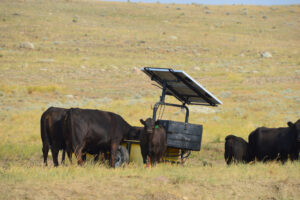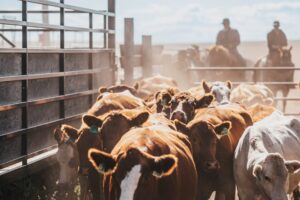Experiencing Drought? Five Things You Can Do To Help Manage Your Herd, Pastures and Health 🎙️
CLICK THE PLAY BUTTON TO LISTEN TO THIS POST:
Listen to more episodes on BeefResearch.ca, Spotify, Apple Podcasts, Amazon Music or Podbean.
Despite recent rainstorms in some regions, drought has once again hit hard in many parts of Canada. Many areas are dealing with multiple years of dry conditions. If you’re managing through a difficult season, the following strategies can help protect your beef cattle operation and your wellbeing.
There is no one-size-fits-all plan to deal with drought, but there are some key things you can do to help manage your pastures, cattle and health during a drought.
1. Take Stock of Your Feed and Forage
The first step in managing drought is to know what you have on hand. This includes:
- Standing forage in pastures
- Carryover hay or silage
- Annual crops that could be harvested for feed
- Alternative feed sources: When grazing salvaged feeds, be aware of any products that have been used on that crop. Fungicides, herbicides or other chemicals used on crops may have withdrawal dates for livestock consumption.
Complete a feed inventory within the next couple of days. Calculate your current feed supply in terms of days or weeks of feed remaining at normal feeding rates. This timeline will drive all other decisions.
Test your feed quality as soon as possible. Feed testing is even more critical in drought years to help make feeding decisions.
Immediate Actions (this week):
- Complete feed inventory
- Test water quality
- Test feed quality
Short-Term Planning (next 1-3 weeks):
- Adjust grazing rotation
- Consider early weaning
- Explore feed purchasing options
Long-Term Strategy (next month):
- Plan for potential herd reduction
- Assess financial resources
- Prepare for recovery
2. Use Grazing Management to Your Advantage
Grazing management can help pastures not only survive during a drought but also improve recovery after one. Some things to consider:
- Group cattle together when rotational grazing, which allows pastures additional time to rest between moves
- Use smaller paddocks: If you have a smaller herd or have already combined groups, using smaller paddocks to graze cattle can also increase the rest time of paddocks not being grazed.
- Protect your soils by leaving litter (plant residue) behind when grazing. This helps trap moisture that does fall, reduces water loss through evaporation, and prevents bare soil from being exposed to the sun and heating up.
- Choose your pasture rotation carefully, knowing which pastures have species that can recover from increased grazing pressure (for example, crested wheat) and grazing those vs. the species that will not respond as well to grazing pressure.
- Keep an eye out for toxic plants. As forage becomes less available, cattle may start to eat plants they would otherwise ignore. Check pastures for toxic plants and consider fencing them out of problem areas.
As tempting as it may be to graze pastures harder than normal during a drought, management practices that promote pasture rest can lead to more overall forage being available and quicker recovery times when rain does hit.
3. Don’t Guess Water and Feed Quality
Drought can significantly impact water quality, particularly in dugouts and ponds.
- Testing your water sources monthly or more often if something seems off can help prevent wrecks from happening.
- Fencing off water sources and pumping to a remote site, such as troughs, will improve water quality and reduce water losses that occur when livestock have access to non-fenced sources.
- Be sure to look at toxin levels in both your feed and water. In years of drought, feed can also be high in nitrates and sulfates, so make sure you are looking at both to get the complete picture.
4. Consider Alternative Feeding Strategies
When pastures can’t support the herd, confinement feeding or supplemental feeding might make sense. With the proper ration, cows can maintain condition on a mix of grain and roughage—even with limited hay.
- Use a tool like CowBytes or work with a nutritionist to build a ration that works with what you have.
- Consider early weaning: Cows are more likely to maintain an adequate body condition when they are not producing milk. Early weaning and creep feeding can reduce stress on the pasture and overall feed requirements because calves consume a significant amount of forage when with their dams.
5. Take Care of Yourself and Your People
Drought is stressful and can be overwhelming. Therapists from the AgKnow Counseling Network recommend the following to help you deal with the stress of drought:
- Acknowledge your reality. It’s okay to point out that this is hard.
- Sleep when you can: Getting a full eight hours of sleep is not always possible during busy seasons, but sleep is essential to rejuvenate your mind and muscles and keep you able to make the best decisions in the moment. When you can, practice good sleep hygiene to help you get a more restful night’s sleep:
- Try not to look at your phone one hour before bed.
- Avoid caffeine after noon.
- Use your bedroom only for sleeping.
- Develop a bedtime routine.
- Check in with yourself: Consider using AgKnow’s anonymous self-check-in tool, How Are You Really.
- “This isn’t forever.“ Drought feels endless, especially for those who have been dealing with it for years, but it’s good to remember it will pass.
- Remember, “success looks different this season.” Focus on things you can control. You may not be able to control the weather or pasture yields, but maybe success in drought looks like managing through it in a way that contributes to long-term sustainability.
- Remind yourself that “This is tough, but I’ve done tough before.” And you will do it again; that is the reality of agriculture. When the clouds build and the rain falls just a few miles away, it’s easy to feel like the weather is against you. But in that moment, try to focus on what’s still yours to manage. That shift in mindset can make a big difference.
- Stay connected. Talk to your neighbours, your family. You’re not in this alone. If the stress is too much, there are people who understand and want to help. There are several ag-informed mental health support organizations in Canada that can provide the support you need.
Decision-Making During a Drought
It’s never easy to make tough calls in a drought year. However, taking stock of the resources available to you and planning accordingly can help reduce risk, protect your land and keep your operation on track for the future.
You don’t have to do it alone; reaching out to extension specialists, local producer groups, nutritionists, veterinarians or mental health specialists can help you to plan for both the short-term and long-term success.
FOR MORE DROUGHT INFORMATION:
- Drought-Related Resources for Cattle Producers (BCRC post)
- Decision Making During Drought (BCRC post)
- Drought Management Strategies (BCRC topic page)
- Experts Respond to Drought Questions (BCRC post)
- More BCRC Drought Resources (BCRC posts)
Thank you to therapists Jenna Ibach and Che Burnett from the AgKnow Counselling Network for providing mental health advice for this article.
Sharing or reprinting BCRC posts is welcome and encouraged. Please credit the Beef Cattle Research Council, provide the website address, www.BeefResearch.ca, and let us know you have chosen to share the article by emailing us at [email protected].
Your questions, comments and suggestions are welcome. Contact us directly or spark a public discussion by posting your thoughts below.



